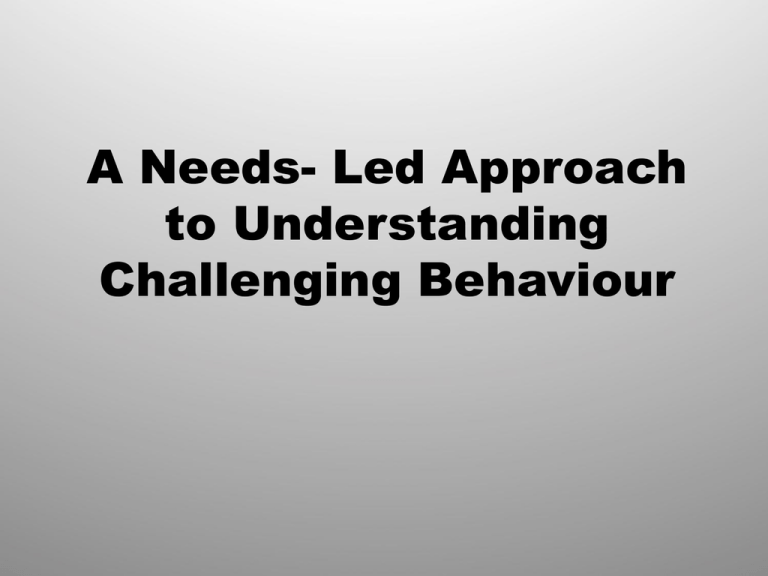
A Needs- Led Approach
to Understanding
Challenging Behaviour
Challenging Behaviour
“Any behaviour which causes significant
distress or danger to the person or others, or
any expression of distress by the person.”
M.Bird(2001)
And the person does not respond to interventions
Challenging Behaviour is behaviour that is
difficult for us to deal with. It leaves us feeling
angry and helpless. Sometimes we feel sad
and hopeless too. But the behaviour is our
challenge.
Our challenge is to understand the
message and engage with the need not
being met
What is the person trying to tell
us?
Why in this way?
What needs are not being met?
How can we meet this person’s
needs?
Common feelings/assumptions about
challenging behaviour
It’s the dementia/stroke/LD
They’ve always been this way
That’s disgusting
This is hopeless
I am helpless to make a change
here
All behaviour is
understandable
on some level
Fundamental Attribution
Error
The tendency to be biased toward
positive explanations for our own
negative actions (e.g. that it was not in
our control, that we were acting out of
character)
and
the tendency to be biased towards more
negative explanations for the negative
behaviour of others
Why is it important to know about the
fundamental attribution error?
We should be aware of our own biases when
we go in to work with CB. We tend to hold a
biased view on why people behave the way
they do.
It is a human phenomenon. We can assume
everybody makes this error at some time re
CB (‘he knows he’s doing it’ v ‘I was drunk, I
wasn’t in control’)
The way we respond to a situation depends
on how we understand the situation and how
it makes us feel
When we are working with relatives/ carers
who have problems with CB, we can help
them by reframing the behaviour (changing
their attributions)
Unmet Needs
It is increasingly recognised that challenging
behaviour in dementia is often an attempt at
communicating an ‘unmet need’. People with
dementia and other mental health problems
often lose the ability to communicate in ways
that we find easy to understand. What we see
as bizarre, sometimes frightening behaviour is
that persons way of telling us what their needs
are.
Introducing the Newcastle (“Columbo”)
Model to Understand Challenging
Behaviour
A needs led formulation based
framework to make sense of
behaviour
and a
Process to apply new knowledge
Understanding Challenging Behaviour
At some level, all behaviour can
be understood
Behaviour that challenges is a
poorly communicated
expression of need
Clinical
experience
Stokes
Newcastle Model/ Columbo approach
Kitwood - PCC
Cohen
Mansfield’s
unmet needs
Cohen-Mansfield’s Unmet Needs Model
Behaviour as a
means of fulfilling
needs
Lifelong habits
& personality
Current
condition –
physical, mental
Environment –
physical, psychological
Unmet
need
Behaviour as a
means of
communicating
needs
Behaviour as outcome of
frustration (n.b. decreased
inhibition)
Application of the Newcastle Model
Using the Colombo approach to
connect information & reach
formulation of difficulties
Identifying unmet needs of patient/
client from formulation
Developing care strategies to meet
needs & manage risk
Two sources of information help us
understand challenging behaviour:
Information about the person
Information about the behaviour
A framework to understand challenging
behaviour
Cognitive
impairment
Mental health
Life history
Personality
Physical
health
Social environment
Medication
Triggers
Behaviour
Appearance
Vocalisation
Cohen-Mansfield’s unmet needs model
Behaviour as a
means of fulfilling
needs
Lifelong habits
& personality
Current
condition –
physical, mental
Environment –
physical, psychological
Unmet
need
Behaviour as a
means of
communicating
needs
Behaviour as outcome of
frustration (n.b. decreased
inhibition)
A process to develop an understanding
of CB
Assessment
Staff
Family & friends
collaborative
inclusive
Formulation presentation
respectful
curious
Care planning and monitoring
The Behaviour
What is happening?
With or to whom is it happening?
Where is it happening?
When is it happening?
How does the client look?
What is the client saying?
What effect does their behaviour have?
The Behaviour
Triggers
When do you notice the behaviour
happening?
Behaviour
(what do you actually see them
do?)
Appearance
Vocalisations
(how do they
look?)
(what do they
say?)
feelings
thoughts
Where’s my mum?
Thoughts
I need to get the kids!
Why is she trying to
take my clothes off?
Challenging behaviour
Actions
Search for lost people
Feelings
Anxiety, fear, anger
Try to leave building,
Fend off care staff
Need to feel safe
NEED TO FEEL SAFE
Need to have some
NEED FOR CONTROL
control
Cognitive Model and Carers
Thoughts
Actions
‘Tell off/ reprimand’
‘Remove from room’
Keep away from her/
him
She’s doing that on
purpose!
He targets the frail
ones!
Feelings
Angry, annoyed
Cognitive Model and Carers
Thoughts
Actions
She doesn’t
understand what’s
going on!
He thinks that person
is stealing from him
Feelings
Re-orientate/ redirect
Sympathy
Change environment etc
Care
Process of delivering the model
Engagement with carers
Assessment
Formulation sessions with
carers
Developing strategies & care
planning
Engagement with Carers
Sales pitch - introductions, selling the
model, clarity around mutual
expectations, telling stories & citing
success
Spotting & addressing sabotage intervention reframed as a treatment
modality, assertive approach,
feedback loops to referrers
Identifying risks
Accommodating needs of the carers
Normalising & empathic response to
distress
Assessment
Holistic assessment taking information from
many sources:
Contextual information:
-
GP records
Psychiatric notes
Families
Spending time in the care environment to gain
understanding of their needs
- Neuropsychological assessment
Information about behaviour:
- Charts completed by carers
- Observations
May involve referrals to other agencies e.g.
continence service, palliative care
Formulation
Formulation Sessions
Identifying the person and
their experience as the
main focus
Pulling the information
together to develop a story
Challenging unhelpful
stories about the person
Creating discomfort with
current position e.g. “she’s
always been like that”
Carers as experts AND
carers as learners –
information giving
Engage carers in finding
solutions
Why Conduct Formulation
Sessions ?
Central to success of
interventions
Avoids ‘Chinese Whispers’
& accusations of ‘ivory
tower’ practitioners
Changes staff perspective
on person
Move from problem to be
solved to needs to be met
Developing Care Strategies
Needs-led
Developed by carers, bespoke to care
environment
3-tier approach to care planning
1. Meeting unmet needs (avoidance)
2. Identify and address antecedent
behaviour (proactive)
3. Manage challenging behaviour
(reactive)
Case Study
75 year old man with longstanding
dementia.
Challenging behaviour – exposing penis
in public
Placement under threat
Family concerns about the future
Social and physical
environment
Moved into EMI residential
care in 2006. Own en-suite
room overlooking the river.
Personalised with own
belongings.
Generally good relationships
with other residents – prefers
female company. Popular
with staff
Regular visits from family
Active participant in
activities.
Physical health:
Generally fit and healthy
Long standing skin problem
on lower leg
Occasional incontinence
Prone to constipation
Requires assistance with
personal care.
Good diet – gaining weight
Medication:
Donepezil 10mg nocte
Quetiapine 25mg nocte
Eurax cream applied daily
Appearance
Matter of fact
Unconcerned
Life history:
Born in 1930 in a local seaside town, one of 5 children – happy
childhood, very close to his siblings; Ran own garage business;
RAF during the war when he met his wife – two children –adored
his family; always loved music and dancing – danced at every
opportunity;
Very proud of his appearance – always wore shirt, tie and jacket;
A practical joker with an excellent sense of humour; Always a bit
of a prude – disliked smutty jokes; ‘page 3’. ‘Victorian’ attitude
towards sex and nudity
Triggers
No obviously apparent trigger but
instances seem to increase when he
is constipated
Behaviour
Unzips his trousers in public
and exposes his penis
NEEDS:
Personality:
Usually gentle and easy going but
could be irritable and bad tempered if
something really annoyed him
Proud and self determined
Very sociable – always a good mixer
A private man who respected the
personal lives of others, and who
expected respect in return
Always ‘busy’ – activities important
to him Disliked “gossips” and “busy
bodies”.
Cognitive impairment:
Memory problems
Disorientated in time and place
Expressive Dysphasia
Word finding difficulties
Visual agnosia
Deficits in reasoning and problem
solving
Mental health:
Visual Hallucinations – seeing small
worm like creatures ‘escaping’ through
the ends of his fingers
Delusions – believing he could conduct
electricity
Vocalisation
“look at this”
Possible Explanations
1.
2.
3.
4.
5.
6.
To meet a sexual need
Trousers too tight – rubbing on
him, causing discomfort or a
sexual response
Expressing a need to urinate
Responding to
delusions/hallucinations
Constipated
Habit – some men seem to
derive comfort from ‘fiddling’
with their bits
Agreed Interventions
1.Determine whether this
behaviour is sexual in nature or
due to some other reason.
2.Rule out the need to urinate
3.Staff feel behaviour is more
frequent when Alfie is constipated
– to monitor bowel habits
4.Alfie to be allowed/supported to
meet any sexual needs he may
have in the privacy of his own
room (to discuss with wife)
5.Obtain bigger trousers for Alfie
(to discuss with wife)
6.When Alfie does expose his penis
staff to ask him to “put it away” –
he usually responds positively
Outcomes
Staffs’ understanding increased
Incidences of exposing penis stopped
altogether
Further medication avoided
Move to EMI nursing avoided






